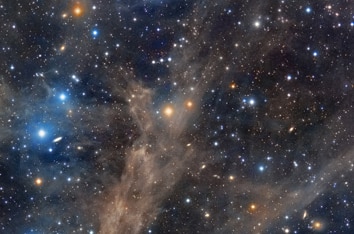Create a free profile to get unlimited access to exclusive videos, sweepstakes, and more!
Guardian of the Galactic Dust

Space isn’t empty.
It may seem that way, when on average a cubic centimeter of the space between the stars—a box the size of a six-sided die—only has a single atom in it. Compare that to the Earth’s atmosphere at sea level, which has 1019 atoms per cc!
But empty it is not. That density is low, but space is big. If you have enough cubic centimeters, even those few particles start to add up. We call this material the interstellar medium, and it’s made up of gas (mostly hydrogen, but with some helium, oxygen, and other elements mixed in) and dust (complex carbon molecules and tiny grains made of lots of other materials including silicates).
This material can glow. Sometimes it’s zapped by ultraviolet radiation from nearby bright stars, causing it to light up literally like a neon sign. Other times this material reflects the light of nearby bright stars.
But what if there are no nearby bright stars? It turns out this material can sill be detected. But it’s really, really hard.
But not too hard for master astrophotographer Rogelio Bernal Andreo! Behold:
That material strewn across the sky is called an Integrated Flux Nebula. That’s a fancy name, and what it means is that instead of reflecting light from one or two nearby stars, it’s actually reflecting light from the background stars in the galaxy itself! The word nebula is Latin for cloud, which is obvious enough. Flux just means energy emitted over time, and integrated just means “all added up.” So this is a cloud of dust we can see because it’s reflecting the overall glow of the galaxy.
It was discovered by astronomer Steve Mandel, who named it (via his son) the Angel Nebula. I can see that! But to my nerdy eyes, I can’t help thinking it should be called the Groot Nebula.
This material is incredibly faint. I poked around a bit, and only found a couple of other images of it, including one by Lynn Hilborn, and another one by Andreo, which he took in 2010; this newer one has twice the exposure time.
This dust is in the constellation of Draco, in the extreme north of the sky, not far from the Big Dipper (about halfway between the “pointer stars” in the Dipper’s bowl and Polaris).
To give you an idea of how feeble this glow is, the star marking Groot’s left eye—called HD 90696—is only 7th magnitude (less than half as bright as the faintest star you can see by eye), and it’s seven times brighter than the star marking his left eye (SAO 7150). The dusty material is spread out, making it even fainter.
Take a look just to the left of Groot and you’ll see a handful of bluer stars. If you look carefully, they appear to be fuzzy—that’s because they’re lighting up the dust in between us and them, making it brighter; the dust appears to have a bluer tint.
Much of this dust is probably only a few hundred light-years from Earth. But you can also see several background galaxies in the photo, too. Those are probably tens to hundreds of millions of light-years away.
Hmmm, with his arms up that way and his eyes flaring, it looks like Groot really is trying to protect those distant galaxies.
And one final note. Material like this can be swept up when a nearby massive star explodes, the material marching across the nearly empty space between stars. Over time, if it hits a denser, larger cloud, that wave of matter can cause the cloud to collapse, forming stars and planets. Our own Sun and Earth probably got their start this way. And you know what that means.
We are Groot.














